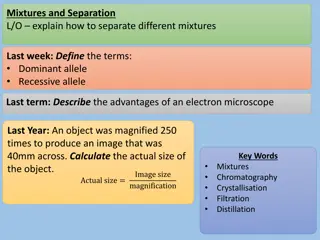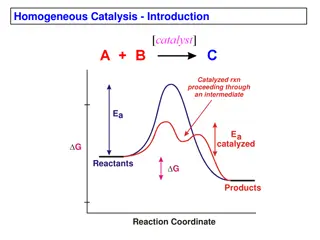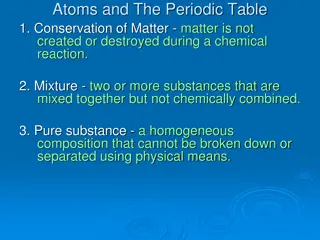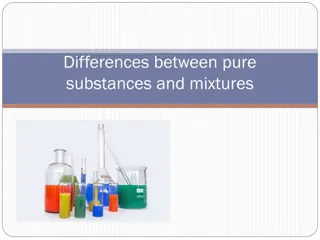Understanding Mixtures: Homogeneous vs Heterogeneous and Separation Techniques
Explore the differences between homogeneous and heterogeneous mixtures, with examples like Cheerios and trail mix. Learn about mixtures like apple juice and orange juice with pulp. Discover how to separate mixtures based on their composition, whether they are homogeneous or heterogeneous, using techniques such as filtration, sedimentation, and distillation.
Download Presentation

Please find below an Image/Link to download the presentation.
The content on the website is provided AS IS for your information and personal use only. It may not be sold, licensed, or shared on other websites without obtaining consent from the author. Download presentation by click this link. If you encounter any issues during the download, it is possible that the publisher has removed the file from their server.
E N D
Presentation Transcript
Heterogeneous vs. Homogeneous Mixtures
How are they different? Homogeneous mixtures have uniform composition Heterogeneous mixtures have non-uniform composition
What type of mixtures are these? Cheerios Trail mix
Cheerios is homogeneous Trail mix is HETEROGENEOUS
What type of mixtures are these? Apple juice Orange juice with pulp Chocolate dough Italian salad dressing
Apple juice is homogeneous Orange juice with pulp is heterogeneous Chocolate dough is homogeneous Italian salad dressing is heterogeneous
What type of mixtures are these? oil & water Mayonnaise, which is mainly made of oil and water
homogeneous heterogeneous
How many components? How many phases? water mayonnaise, (made of oil & water) oil & water
How many components? How many phases? . water phase water phase and oil phase Water phase, oil phase, and many other phases
How would you separate mixtures? It depends on the type of mixture, whether they are homogeneous or heterogeneous
Mixture Separation Techniques Homogeneous Mixtures Heterogeneous Mixtures filtration hand picking magnetic separation sieving winnowing sedimentation centrifugation coagulation distillation evaporation
Solution-Based Mixtures True solution Colloidal solutions Suspensions These solutions typically differ in the particle size of the solute.
Solution-Based Mixtures True solution: solute size: <1 nm Colloidal solutions: solute size: 1 nm to 100 nm Suspensions: solute size: >100 nm These solutions typically differ in the manner in which the solutes reside in the solvent.
Solution-Based Mixtures True solutions: The solute is dissolved and is invisible Colloidal solutions: The solute is dispersed uniformly throughout the solution; the presence of the solute is visible, but you cannot lift it out Suspensions: The solute stays outside the solvent; that is, the solute is suspended These solutions typically differ in the manner in which the solute can be separated from the solvent.
Separation Techniques for Solution-Based Mixtures True solutions evaporation distillation Colloidal solutions coagulation centrifugation Suspensions filtration sedimentation We will discuss coagulation, centrifugation and sedimentation























